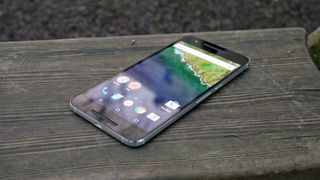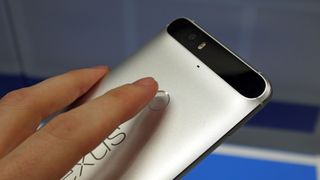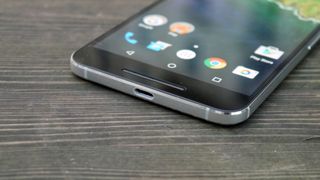Why you can trust TechRadar
The Nexus 6P challenges the Samsung Galaxy Note 5 and Moto X Style with a 5.7-inch display and Quad HD resolution, as it keeps pace with its fellow Android juggernauts.
That's because it's backed by similar technology – a 5.7-inch AMOLED display, which contrasts with the IPS LCD found in the Nexus 5X, LG G4 and iPhone 6S.
The screen has a 2,560 x 1,440 resolution with a dense 518 pixels per inch, and, all around it looks brighter and more colorful than the Nexus 6, which also had a dimmer Quad HD display at the same resolution.
Brightness is undoubtedly higher when "adaptive brightness" is turned off, and color accuracy is a step in the right direction compared to what we saw from its predecessor.

Without diving into the developer settings and changing things around (which most people won't do), I found that the screen is still more saturated than it is true-to-life. Heavy saturation works on some subjects, like vibrant-looking red strawberries, but looks unnatural on actors faces if they with a slight Hollywood tan.
The Nexus 6P retains the Adaptive Display functionality from Motorola's Nexus 6. Whenever the phone is picked up or a notification arrives, it flashes a grayscale notification lockscreen.
I prefer the gesture-sensing Moto Display, which uses tiny IR sensors embedded in the front of the phone to detect motion or a hand wave and then display the time and peekable notifications.
The screen also doesn't have the common double-tap-to-wake function found on the LG G4 and HTC One M9. That would've helped, given the rear-facing fingerprint sensor.
Fingerprint sensor
The Nexus 6P's aluminum unibody doesn't attract fingerprints like the smudge-filled Nexus 5 in black with its soft-touch coating. But it does have one spot where fingerprints are wholly acceptable.
Google's Nexus Imprint Sensor is introduced in the Nexus 6P and Nexus 5X, and it works a lot like other biometric fingerprint sensors out there, including Apple's Touch ID home button.

There are two key differences. Registering a new fingerprint takes no longer than eight seconds, whereas Apple and Samsung's methods require too many long presses and pauses.
More strikingly, the fingerprint sensor is on the back and static – it doesn't double as a button that you can press down. Google's hypes this spot as a natural location for your fingers.
My index finger, usually resting along the frame, disagreed at first. I had to learn to bend it around back to unlock the phone, and it was initially awkward, but I eventually got used to it.
It's a little easier to pull off on the smaller Nexus 5X, but the tradeoff is that I didn't smudge the Nexus 6P camera, which is off-center and further away than on the 5X.

On either phone, it takes half a second to unlock the phone and, even with the fast setup time, the sensor is just as accurate as Apple's and Samsung's.
However, I still find myself using archaic unlock methods, simply because it's easier than picking up this 5.7-inch phone whenever it's resting on my desk or a table.
This is where front-facing fingerprint sensors work best. However, between you and me, I find that the Nexus 6P is ideal when 'talking' to someone, but really nonchalantly unlocking my phone in back. Sneaky, sneaky.
USB-C connection
Google's Nexus design evolution is reflected in more than just the matte aluminum build. The Nexus 6P makes the jump to charging and transferring data via USB Type-C.
This means your stash of micro USB cables is useless, and you'll have to tout around this new connector and charging block. Forget it – or worse, lose it – and your phone's battery life is in jeopardy.
Changes like this are always a bit jarring, and I feel like I have too many cables already. Every other Android phone and tablet I have uses micro USB, and my Apple devices use Lightning.

My Apple Watch and Android Wear smartwatches take advantage of multiple inductive chargers, and a few holdouts like GoPro still require a USB mini. My bag is full of chargers, and this is just one more.
But, once everyone gets on the same page, the advantage is clear: USB-C offers faster charging times, and the connector is reversible – I never fumble around with inserting it into the Nexus 6P.
Google at least made the transition easier. The Nexus 6P comes with a USB-C-to-USB cable, so you can still charge and transfer files into a computer with normal USB-A port. The Nexus 5X doesn't offer the same accessory for free.
Current page: Display, fingerprint sensor and USB-C
Prev Page Introduction and design Next Page Specs and performance
Amazon Prime Video's disappearing act could point to a future without the service

Tesla Cybertruck suffers new recall for a very scary problem

'The party is over for developers looking for AI freebies' — Google terminates Gemini API free access within months amidst rumors that it could charge for AI search queries

